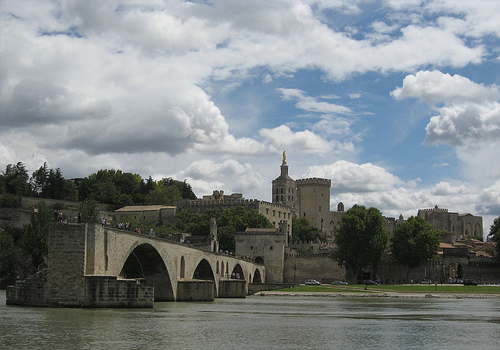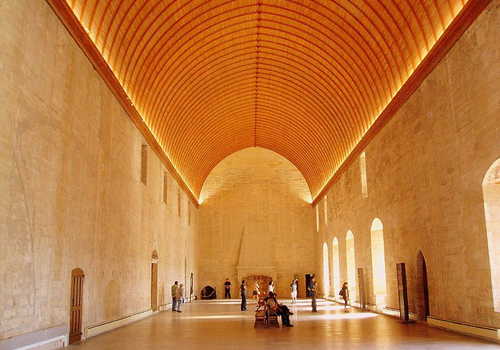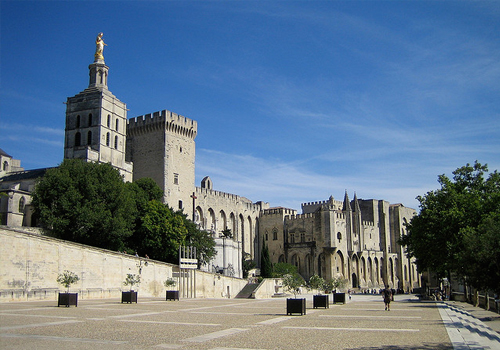Avignon Travel Guide
Palais des Papes
Address: Place du Palais, 6 Rue Pente Rapide Avignon
Towering over Avignon, the imposing Palais des Papes (Palace of the Popes) is the symbol of the city's medieval power. The palace consists of the ascetic Old Palace, commissioned by Benedict XII, and the extravagant Gothic New Palace of Clement VI. It was built primarily as a fortress with massive outer walls, battlements and sluices for pouring hot oil onto attackers. Inside the palace, so little remains of the original interior that visitors could be mislead into believing that all the popes and their entourage were as virtuous as the last official occupant, Benedict XIII. In reality, the interior was once elaborately decorated, displaying the decadence of the feuding cardinals and their mistresses. The fire of 1413 destroyed most of the decoration and furnishings, but evidence of the once magnificent interior does remain and includes some frescoes, one of which was painted by Italian artist Matteo Giovannetti. Visitors can take a fascinating tour of the palace and see the Pope's Bedchamber, the Chapelle St-Martial and the Stag Room. Nearby, dwarfed by the palace, is the 12th-century Cathédrale Notre-Dame des Doms.<br /><br />
Petit Palais
Address: Place du Palais Avignon
Just below the Palais des Papes, the Petit Palais contains a wonderful collection of 13th to 15th-century paintings and sculptures. Although there are interesting examples of art from the region, much of the collection consists of the work of Italian masters from that era and, progressing through the 19 rooms, one can observe how they wrestled with and finally conquered the representation of perspective; in medieval art the size of figures depended on their importance rather than position so this was a revolution in art. The highlights of the collection are Botticelli's sublime and The by Sano Di Pietro. There are also a plenitude of beautiful Christian icons in the collection. It is a small museum and information in English is minimal so those interested in the art need to buy a brochure or guidebook to get context. Although it has a lot to offer enthusiasts this museum is not a must-see for those who are indifferent to art history.<br /><br />
Pont dAvignon
Address: Pont dAvignon, Boulevard de la Ligne, 84000 Avignon Avignon
Behind the Petit Palais is the much photographed Pont d'Avignon, also known as the Pont Saint-Bénezet, and fondly immortalised in the famous children's song of the same name. The bridge was originally built in the 12th century to shorten the journey for the busy traders ferrying their goods between the Mediterranean and Lyon. The torrents of the Rhône regularly damaged and brought down sections of the bridge and builders finally gave up repairing it in 1660, four centuries after it was built. Today only four of the original 22 arches remain. On the first of the bridge's bulwarks is the tiny Chapelle St-Nicholas, and this delicate Romanesque chapel, dedicated to St Nicholas, patron saint of bargemen, is well worth a visit. There is a wonderful audio guide available to give visitors the history of the bridge and its cultural significance (and allow them to sing along to a few different versions of the song). Try and avoid the busiest times because the bridge can get a bit crowded and as the attraction's appeal is mainly atmospheric too many people can ruin it. Those who aren't keen to see the lovely little chapel should consider walking up to the park on the hill which overlooks the bridge to simply admire the views. Sitting on the river banks is similarly a very pleasant way to pass the time.<br /><br />
(Data provided outside US and Canada by Foreca, Data provided for US and Canada by WDT)
| Jan | Feb | Mar | Apr | May | Jun | Jul | Aug | Sep | Oct | Nov | Dec | |
| Average High | 9° | 11° | 15° | 19° | 23° | 27° | 30° | 30° | 25° | 20° | 13° | 10° |
| Average Low | 1° | 2° | 5° | 7° | 10° | 14° | 16° | 15° | 13° | 9° | 5° | 2° |
(Data provided outside US and Canada by Foreca, Data provided for US and Canada by WDT)
| Jan | Feb | Mar | Apr | May | Jun | Jul | Aug | Sep | Oct | Nov | Dec | |
| Average High | 4° | 53° | 59° | 67° | 74° | 82° | 87° | 87° | 78° | 68° | 56° | 50° |
| Average Low | 34° | 36° | 41° | 45° | 51° | 58° | 61° | 60° | 57° | 49° | 41° | 37° |
| Description Round pins, grounding pin and receptacle. |
Voltage 230 V |
Frequency 50 Hz |
Type E |


